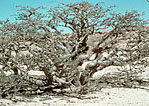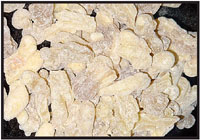| Olibanum/Incense |

|
| Olibanum Plant |

|
Scientific Name: Boswellia sacra AKA B.carterii or B.thurifera)Boswellia frereana, Boswellia papyrifera, Boswellia serrata.
Family: BURSERACEAE . Common Name: Incense. It is also called frankincense.
The incense tree is a small, tortuous tree which grows to 3 to 10 m high. It usually has many branches around its base.
The leaves are composite, pinnate, alternate, and arranged in dense bunch at the extremity of the branches. The inflorescence
of small, white flowers constitutes long, erect bunches located in an axillary position.
The bark looks like paper and exfoliates naturally. The inner bark contains canals that secrete resin.
It is originated from Southern Saudi Arabia, North Yemen, West Oman, Ethiopia, and Somalia. The environment it loves
is sub-desert climate, in the bed of a ravine or in cracks in rocks, in chalky soil. An incision is made in the trunk to extract
the resin, which appears in the form of pale yellow to amber tears. Incense is harvested from wild trees after propagation
using cuttings. Other species of the Burseracea family produce resins that smell like incense such as the Boswellia genus:
B. papyrifera (Sudan, Ethiopia), B. carterii (Somalia). B. serrata (dry zones of India).
It blooms in the spring, but it is not uncommon for some flowering in December.
The resin is collected after the incision and is dried into grey color chalky chunks. The incense resin is later extracted
via infusion. The resin has balsamic , spicy and woody odor.
It is widely used in the production of eau de toilettes for men and women in perfumery.
Some perfumes which use Olibanum:
| Olibanum Incense Resin |

|
|
|
|

